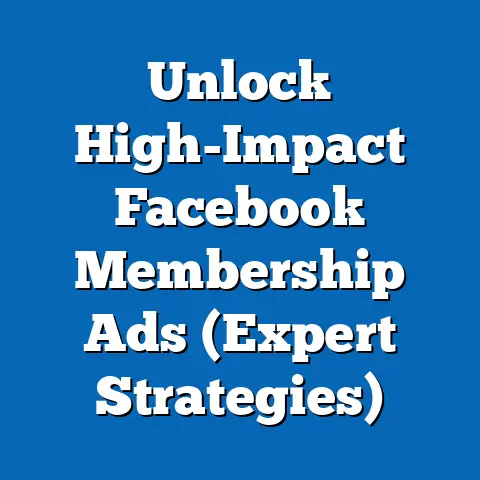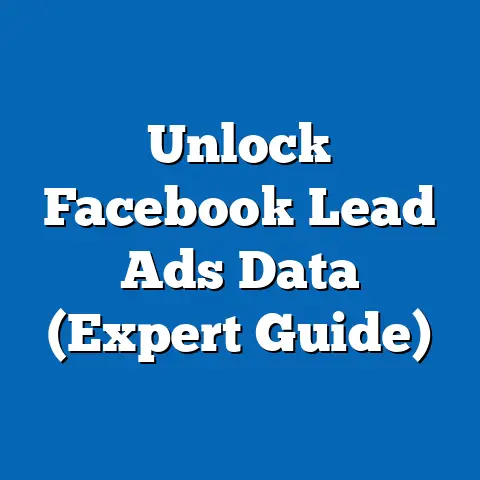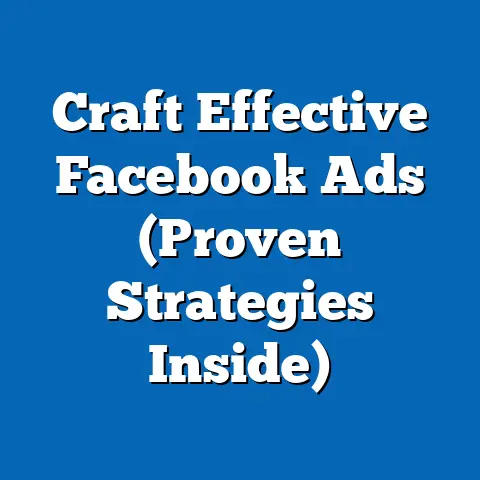Boost Facebook Ads ROI with Stellar Customer Service (Pro Secrets)
Hey there, fellow marketers! Remember the last time you reached out to a brand for help and felt genuinely valued? That feeling of being heard and appreciated can turn a simple inquiry into a loyal customer relationship. And believe it or not, that same level of care and attention can drastically improve your Facebook Ads ROI.
I’ve spent years in the trenches of digital marketing, and one thing has become crystal clear: stellar customer service isn’t just a nice-to-have; it’s a core component of a successful advertising strategy, especially on a platform as social and interactive as Facebook. Let’s dive into how you can leverage top-notch customer service to supercharge your Facebook ads!
1. The Connection Between Customer Service and Advertising Success
Let’s face it: advertising doesn’t exist in a vacuum. Your ads might be brilliant, your targeting laser-focused, but if your customer service is lacking, you’re essentially pouring money down the drain. Think of it like this: your ads are the first impression, but customer service is the long-lasting relationship.
A study by Microsoft found that 96% of consumers globally say customer service is an important factor in their choice of loyalty to a brand. That’s a staggering number! And it directly translates to your ad performance. Imagine a potential customer clicks on your ad, visits your website, and then reaches out with a question. If they’re met with slow responses, unhelpful answers, or a generally frustrating experience, they’re unlikely to convert – no matter how compelling your ad was.
On the flip side, a positive customer service interaction can turn a hesitant prospect into a paying customer and even a brand advocate. I’ve seen this firsthand. I once worked with a small e-commerce business selling handmade jewelry. Their initial Facebook ads were performing poorly, with low conversion rates and high cost-per-acquisition. After digging deeper, we discovered that customers were hesitant to purchase due to concerns about shipping times and return policies. We revamped their customer service process, providing prompt and helpful answers to these questions, and saw a 40% increase in conversion rates from their Facebook ads within a month!
Key Takeaway: Customer service isn’t just about solving problems; it’s about building trust and confidence in your brand, which directly translates to improved ad performance.
2. Understanding Your Audience
Before you can provide stellar customer service, you need to understand who you’re serving. This goes beyond basic demographics. You need to know their needs, pain points, and preferences. What are their biggest concerns when considering your product or service? What kind of language do they use? What are their expectations for customer service?
Effective customer service is a goldmine of information for understanding your audience. Every interaction is an opportunity to learn something new. What questions are they asking most frequently? What are they struggling with? What are they praising?
I remember working with a SaaS company that had a very generic customer service approach. They treated every customer the same, regardless of their plan or usage. By analyzing their customer service data, we realized that their enterprise customers had very different needs and expectations than their individual users. We segmented their customer service, providing dedicated support and personalized onboarding for enterprise clients. This not only improved customer satisfaction but also allowed us to tailor their Facebook ads to address the specific pain points of each segment, resulting in a significant increase in lead generation for their enterprise offering.
Key Takeaway: Use customer service interactions as a source of valuable insights into your audience. These insights can then be used to refine your Facebook ad targeting and messaging for better results.
3. Creating a Seamless Customer Experience
A seamless customer experience is one that is smooth, consistent, and effortless for the customer. It starts from the moment they see your ad and extends long after they make a purchase. This means ensuring that your website is easy to navigate, your checkout process is straightforward, and your customer service is readily available and helpful.
One of the biggest mistakes I see businesses make is creating friction in the customer journey. For example, an ad might promise a free trial, but when the customer clicks through, they’re forced to fill out a long and complicated form. Or, a customer might have a question about their order, but they can’t find a phone number or email address to contact customer service.
To create a seamless experience, map out the entire customer journey, from ad click to post-purchase follow-up. Identify any potential pain points or areas of friction and work to eliminate them. Make it easy for customers to find the information they need, contact customer service, and complete their purchase.
Positive reviews and social proof are a direct result of a seamless customer experience. Happy customers are more likely to leave positive reviews, which can significantly enhance the credibility of your Facebook ads. Think of it this way: a glowing review from a satisfied customer is far more persuasive than any marketing copy you can write.
Key Takeaway: Map the customer journey, eliminate friction, and create a smooth and effortless experience. This will lead to positive reviews and social proof, which can boost the credibility and effectiveness of your Facebook ads.
4. Leveraging Feedback for Ad Optimization
Customer feedback is a treasure trove of information that can be used to refine your Facebook ad campaigns. By actively listening to your customers, you can identify areas where your ads are falling short and make adjustments to improve their performance.
There are several ways to collect customer feedback, including:
- Surveys: Send out surveys to recent customers to gather feedback on their experience with your product or service.
- Social Listening: Monitor social media channels for mentions of your brand and product. Pay attention to both positive and negative feedback.
- Customer Service Interactions: Analyze customer service interactions to identify common questions, complaints, and praise.
- Reviews: Read online reviews on platforms like Google, Yelp, and Facebook.
Once you’ve collected feedback, analyze it to identify key themes and trends. What are customers saying about your product or service? What are they struggling with? What are they praising?
Use this feedback to improve your ad targeting and messaging. For example, if customers are complaining about the high cost of shipping, you might consider offering free shipping in your ads. Or, if customers are praising the quality of your product, you might highlight that in your ad copy.
I once worked with a clothing retailer that was struggling to generate sales from their Facebook ads. After analyzing customer feedback, we discovered that many customers were hesitant to purchase online because they were unsure about sizing. We created a series of ads that addressed this concern, providing detailed sizing charts and offering free returns for items that didn’t fit. This resulted in a significant increase in sales from their Facebook ads.
Key Takeaway: Actively collect and analyze customer feedback to identify areas where your ads are falling short. Use this feedback to refine your ad targeting and messaging for better results.
5. Personalization: The Key to Customer Satisfaction
In today’s digital landscape, generic advertising simply doesn’t cut it. Customers expect personalized experiences that are tailored to their individual needs and preferences. And this extends to your Facebook ads.
Personalized customer service plays a crucial role in creating lasting impressions. When you take the time to understand your customers and address their specific concerns, you’re showing them that you value their business. This can lead to increased loyalty and advocacy.
There are several ways to personalize your Facebook ads based on previous interactions and customer data. You can use Facebook’s Custom Audiences feature to target ads to people who have previously visited your website, purchased your product, or interacted with your brand on social media.
You can also use dynamic product ads to show customers products that they’ve previously viewed on your website. This is a highly effective way to re-engage potential customers and drive sales.
I once worked with a travel agency that was using generic Facebook ads to promote their vacation packages. We implemented a personalized advertising strategy, targeting ads to people who had previously searched for specific destinations on their website. We also created ads that highlighted the unique benefits of each vacation package, based on the customer’s interests and preferences. This resulted in a significant increase in bookings from their Facebook ads.
Key Takeaway: Personalize your Facebook ads based on previous interactions and customer data. This will make your ads more relevant and appealing, leading to higher engagement and conversion rates.
6. Building a Community Around Your Brand
Building a community around your brand can be a powerful way to drive organic promotion of your Facebook ads. When you foster a community of loyal customers, they’re more likely to share your ads with their friends and family, leave positive reviews, and advocate for your brand.
Excellent customer service is essential for building a strong community. When you provide exceptional service, you’re showing your customers that you care about them and their needs. This will help you build trust and loyalty, which are essential for fostering a community.
There are several ways to build a community around your brand on Facebook, including:
- Creating a Facebook Group: Create a Facebook Group where your customers can connect with each other, share their experiences, and ask questions.
- Running Contests and Giveaways: Run contests and giveaways to engage your audience and reward their loyalty.
- Hosting Live Q&A Sessions: Host live Q&A sessions with your team to answer customer questions and provide valuable insights.
- Sharing User-Generated Content: Share user-generated content, such as photos and videos, to showcase your customers and their experiences.
I once worked with a fitness brand that built a thriving community around their products on Facebook. They created a Facebook Group where customers could share their workout routines, ask questions, and support each other. They also ran regular contests and giveaways to engage their audience. As a result, their customers became passionate brand advocates, organically promoting their products and Facebook ads to their friends and family.
Key Takeaway: Foster a community of loyal customers by providing excellent customer service and engaging your audience on Facebook. This will lead to organic promotion of your Facebook ads and increased brand awareness.
7. Training Your Team for Success
Your customer service team is the face of your brand. They’re the ones who interact directly with your customers, answer their questions, and resolve their issues. It’s crucial to train your team to handle inquiries effectively and empathetically.
Equip your team with the right tools and resources to enhance their interactions with customers. This includes providing them with access to a knowledge base, a CRM system, and a live chat platform.
Train your team to be proactive in identifying and resolving customer issues. Encourage them to go above and beyond to provide exceptional service.
I once worked with a restaurant that was struggling to manage their online reputation. We implemented a customer service training program that focused on empowering their team to handle online reviews and complaints effectively. We taught them how to respond to negative reviews professionally and empathetically, and how to turn negative experiences into positive ones. As a result, they saw a significant improvement in their online reputation and an increase in customer satisfaction.
Key Takeaway: Invest in training your customer service team to handle inquiries effectively and empathetically. Equip them with the right tools and resources to enhance their interactions with customers.
8. The Role of Technology in Customer Service
Technology can play a significant role in streamlining customer service and enhancing the Facebook ads experience. Chatbots, CRM systems, and other tools can help you automate tasks, personalize interactions, and provide faster and more efficient service.
Chatbots can be used to answer frequently asked questions, provide product information, and even process orders. This can free up your customer service team to focus on more complex issues.
CRM systems can help you track customer interactions, personalize communications, and provide a more consistent experience.
I once worked with an e-commerce business that implemented a chatbot on their Facebook page. The chatbot was able to answer common questions about shipping, returns, and order status. This significantly reduced the workload on their customer service team and allowed them to focus on more complex issues. As a result, they saw a decrease in customer service costs and an increase in customer satisfaction.
Key Takeaway: Leverage technology to streamline customer service and enhance the Facebook ads experience. Chatbots, CRM systems, and other tools can help you automate tasks, personalize interactions, and provide faster and more efficient service.
9. Measuring the Impact of Customer Service on Ad ROI
It’s important to measure the effectiveness of your customer service efforts on your Facebook ad ROI. This will allow you to identify areas where you’re succeeding and areas where you need to improve.
There are several key performance indicators (KPIs) that you can track, including:
- Customer Satisfaction Scores: Measure customer satisfaction using surveys or feedback forms.
- Engagement Rates: Track engagement rates on your Facebook ads, such as clicks, likes, and shares.
- Conversion Metrics: Measure conversion metrics, such as sales, leads, and sign-ups.
- Customer Lifetime Value: Calculate the lifetime value of your customers.
By tracking these KPIs, you can get a clear picture of how your customer service efforts are impacting your Facebook ad ROI.
Key Takeaway: Track key performance indicators (KPIs) to measure the effectiveness of your customer service efforts on your Facebook ad ROI.
10. Pro Secrets from Industry Experts
I’ve asked a few of my colleagues and industry experts for their top secrets to boosting Facebook Ads ROI with stellar customer service. Here’s what they had to say:
- Sarah, Head of Marketing at a SaaS Company: “We use customer service interactions to identify our ideal customer profile and then target our Facebook ads accordingly. It’s like getting insider information straight from the source!”
- David, E-commerce Entrepreneur: “Don’t underestimate the power of a personalized thank-you message after a purchase. It shows you care and builds loyalty, which translates to repeat purchases driven by our Facebook retargeting ads.”
- Maria, Social Media Consultant: “We actively monitor social media for mentions of our clients’ brands and respond to any complaints or concerns immediately. Addressing these issues publicly shows that you’re committed to customer satisfaction and can influence potential customers who see your Facebook ads.”
These insights highlight the importance of integrating customer service into your overall advertising strategy. It’s not just about solving problems; it’s about building relationships and creating a positive brand experience.
Key Takeaway: Learn from the pros! Integrate customer service into your overall advertising strategy and focus on building relationships with your customers.
Conclusion:
As we’ve explored, stellar customer service is more than just a support function; it’s a strategic asset that can significantly boost your Facebook Ads ROI. By understanding your audience, creating seamless experiences, leveraging feedback, personalizing interactions, building a community, training your team, embracing technology, measuring your impact, and learning from the pros, you can transform your customer service into a powerful driver of advertising success.
Now, I encourage you to reflect on your own customer service practices and consider how you can implement the strategies discussed to elevate your advertising efforts and foster loyalty among your customers.
Call to Action:
What are your thoughts? Share your experiences or insights related to customer service and Facebook advertising in the comments below or on social media. Let’s learn and grow together!






